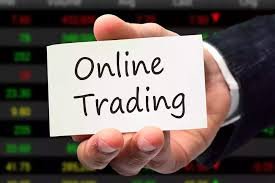Introduction:
Remember when stock trading involved calling your broker, wearing suits, and yelling across a trading floor? Well, those days are over. Now, online trading has revolutionized the way individuals invest, enabling anyone with a smartphone and an internet connection to tap into global financial markets—straight from their couch.
Whether you want to grow your savings, create passive income, or just experiment with the markets, online trading has opened the doors wider than ever. But with opportunity comes complexity. This guide is here to demystify the nuts and bolts of online trading—what it is, how it works, and how you can get started without getting lost in the jargon.
What Is Online Trading?
Online trading is the process of purchasing and selling financial products—like stocks, cryptocurrencies, forex, and commodities—through internet-based platforms. It does away with the necessity of a conventional broker or trading floor and puts the power in the hands of individual investors.
Types of Online Trading:
- Stock Trading: Purchasing shares of publicly traded companies.
- Forex Trading: Currency trading in the foreign exchange market.
- Cryptocurrency Trading: Digital currency trading such as Bitcoin, Ethereum, etc.
- Options and Futures: Securities whose value is determined by a value that some other asset has.
- CFDs (Contracts for Difference): Trading the asset without ever possessing it.
- ETF and Mutual Fund Trading: Trading a basket of assets at less risk.
Real-World Example:
Sarah, a 29-year-old Dubai-based graphic designer, began part-time trading over the pandemic. With an app such as eToro, she started trading tech stocks and cryptocurrencies with only $500. Two years on, she has built her portfolio to more than $4,000—all via her phone.
The Evolution of Trading: From Floor to Click
The democratization of finance did not happen overnight. Here’s a brief rundown of how we ended up here
- 1990s: Initial online trading platforms such as E*TRADE appeared.
- 2000s: Online brokers lowered fees, enhancing access to recreational investors.
- 2010s: Mobile apps such as Robinhood and eToro transformed trading among millennials.
- 2020s: Crypto exchanges and AI-powered platforms transformed the scene even more.
As per Statista, the global online trading market will reach more than $12 billion by 2028, fueled by digital accessibility and retail investor demand.
Why Using the Right Trading Platform is Important
Picking the right trading platform is more than a question of cheap fees or cool design. It’s about:
Regulatory Compliance: Having the platform be licensed and regulated by solid authorities such as the UAE’s Securities and Commodities Authority (SCA) or the Dubai Financial Services Authority (DFSA).
Asset Diversity: Having access to a broad variety of financial products, from local to international stocks, ETFs, forex, and beyond.
User Experience: An easy-to-use interface that is accessible to both novices and professional traders.
Educational Resources: Access to tutorials, webinars, and other educational materials to facilitate ongoing learning.
Customer Support: Supportive and informed support staff to aid with any problems or questions.
How Online Trading Platforms Work
When you register with an online trading platform, you’re essentially getting access to a virtual trading desk. Here’s why and how it works:
Key Features of Most Platforms:
- Real-time charts & analytics
- Trading dashboard
- Order execution (buy/sell)
- Watchlists & alerts
- News integration
- Social trading (on platforms like eToro)
Popular Online Trading Platforms (2025 Edition):
| Platform | Best For | Notable Feature |
| eToro | Beginners & social traders | Copy Trading portfolios |
| Interactive Brokers | Advanced users | Global market access |
| Robinhood | Commission-free trading | User-friendly mobile app |
| Binance | Crypto traders | Deep liquidity and low fees |
| Saxo Bank | High net-worth traders | Premium analytical tools |
Pros and Cons of Trading Online
Before taking the plunge, it is essential to know both sides of the coin.
✅ Pros:
- Accessibility: Trade anywhere, anytime.
- Low Fees: Commission-free or low fees.
- Real-time Control: Instant execution and decision-making.
- Wide Market Access: From NYSE to NASDAQ to crypto markets.
- Educational Tools: Many sites provide demo accounts and tutorials.
❌ Cons:
- Volatility Risks: The markets can fluctuate wildly.
- Overtrading: Ease of access can promote impulsive trades.
- Scams and Fraud: Particularly in unregulated crypto markets.
- Learning Curve: Losses are probable without the right knowledge.
How to Begin Online Trading: Step-by-Step
Trading may appear complicated, but beginning is unexpectedly easy. Here’s a beginner’s guide:
- Set Your Goals
Do you want to make quick profits, accumulate long-term wealth, or acquire a new skill?
- Select a Regulated Broker
Always use platforms regulated by bodies such as:
UAE: Securities and Commodities Authority (SCA)
USA: SEC, FINRA
UK: FCA
- Open a Trading Account
Most sites enable you to sign up in minutes with your ID, email, and banking info.
- Fund Your Account
Deposit money with bank transfer, credit card, or even cryptocurrency (on some websites).
- Learn Before You Trade
Practice on demonstration accounts or begin with minimal capital. Learn about charts, review trends, and learn what influences markets.
- Place Your First Trade
Click asset → click amount → click buy/sell → execute the trade.
Key Strategies Every Trader Should Know
Whether you’re a newbie or seasoned investor, these strategies help manage risk and maximize returns:
- Dollar-Cost Averaging (DCA)
Invest fixed amounts regularly regardless of market conditions. Great for long-term investors.
- Swing Trading
Observe short-term price behavior on days or weeks.
- Day Trading
Buy and sell within the same day. High risk, high reward. Requires fast decision-making.
- Trend Following
Ride the trend of popular assets. Technical tools such as moving averages assist here.
- Risk Management
Never risk capital you cannot afford to lose. Implement stop-loss and take-profit orders to contain losses.
New Traders’ Mistakes (And How to Avoid Them)
- Chasing Hype: Don’t jump into trends without due diligence.
- Ignoring Fees: Commissions may seem minor but can add up over time.
- No Exit Strategy: Cut your losses and know when to exit—whether profit or loss.
- Overleveraging: Leveraging borrowed capital can exacerbate losses.
- Emotional Trading: Greed and fear are your most unfaithful trading companions.
Pro Tip: Maintain a trading journal. Log your wins, losses, and takeaways.
Real-World Impact: The Tale of Ahmed the Engineer
Ahmed, an Abu Dhabi engineer aged 34, began trading in the COVID-19 lockdown. He was first attracted to crypto trends and lost $2,000 pursuing meme coins. But he didn’t give up. Instead, he enrolled in a certified online trading course, switched to ETFs and blue-chip stocks, and now generates steady monthly returns of an average 6%.
The Future of Online Trading
While AI, blockchain, and big data keep on advancing, the world of online trading is getting smarter and faster.
What to Watch Out For:
AI-powered robo-advisors
Fractional trading
Social investing platforms
DeFi (Decentralized Finance) protocols
Tokenization of assets (real estate, art)
A 2024 CNBC survey indicates that more than 43% of Gen Z and millennials now include online trading in their financial planning strategy.
Final Thoughts: Is Online Trading For You?
Online trading isn’t a get-rich-quick scheme. It’s a potent tool—if handled sensibly. It provides flexibility, convenience, and the possibility of substantial gains. But as with any tool, it needs knowledge, self-discipline, and a clear strategy.
Whether you’re investing long-term or wanting to be the next day-trading genius, the journey starts with one click—but success is based on what you do next.









